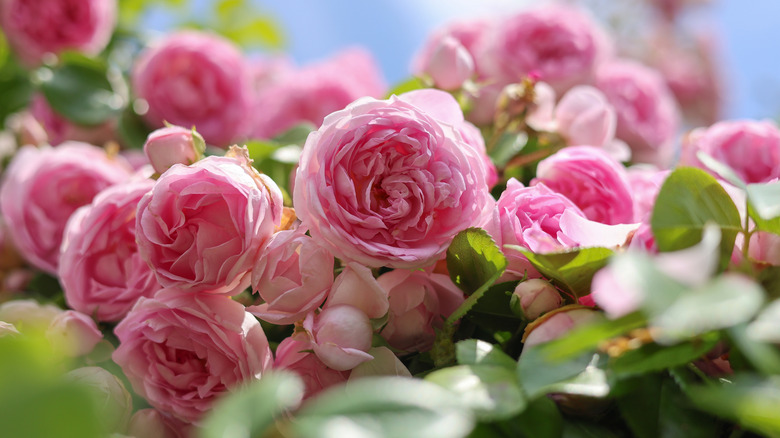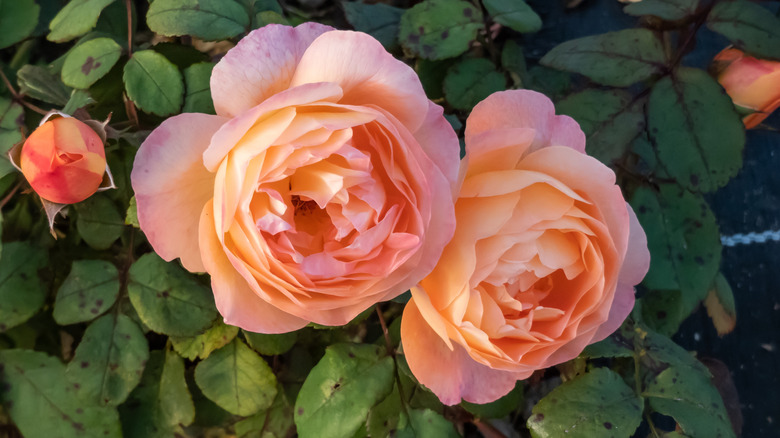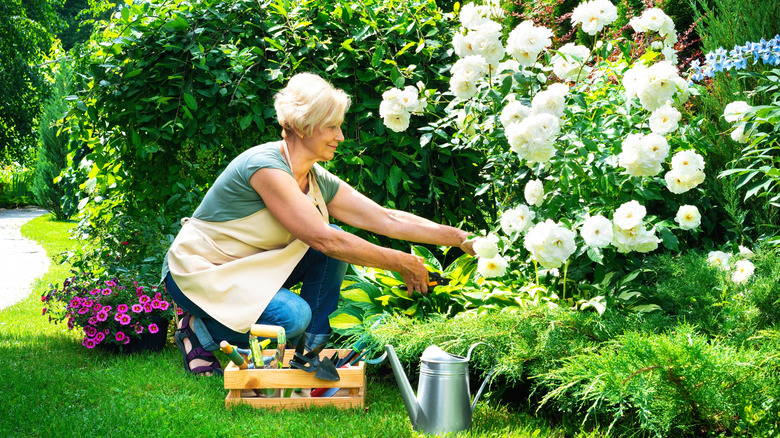Plant These Types Of Roses For More Fragrant Flowers
"A rose by any other name would smell as sweet." Or would it? This memorable line from Shakespeare's "Romeo and Juliet" actually had very little to do with the scent of roses and more to do with teenage hormones. But with more than 150 different species of roses (Rosa), many of them have wildly different scent profiles depending on how these perennial flowers are bred.
While some roses are cultivated for their shape, color, or petal count, others are bred for their unique scent. If you're familiar with the term "tea rose," it bears its name due to a crossbreed between a Chinese rose and a European rose that ended up smelling just like a cup of tea. Tea roses, damask roses, shrub roses, and old roses have stronger fragrances. Other roses, like China roses, modern hybrids, and modern garden roses, however, have little to no scent at all. This is mainly due to rose breeders attempting to grow larger, more colorful flowers that have a longer shelf life or are resistant to disease. To achieve these ends, a strong fragrance profile gets lost in the equation.
But before all this cross-breeding and cultivation began, roses still had a natural scent — like most flowers – to attract bees and other pollinators. Even in its most organic form, the strength of a rose's fragrance can vary somewhat depending on weather conditions such as warmth and humidity, the age of the bloom, where's it grown, and even the time of day you take a sniff. For home growers who want to get back to basics, the good news is that as long as you avoid a lot of synthetic fertilizers and pesticides, you can still grow very fragrant roses.
The scent bouquet of your flower bouquet
We're all familiar with the term "bouquet" to describe an attractive bunch of specifically selected flowers. But "bouquet" also refers to the scent of an item, such as wine or perfume. If you've ever been to a wine tasting, you might be surprised at the words used to describe the bouquet of this drink made from fermented grapes. Vanilla? Gingerbread? Walnut? Buttered toast? Alas, in the world of rose sniffery, there are also some surprising scent descriptors. Would you believe pear, myrrh, citrus, licorice, nutmeg, melon, and pumpkin pie?
The names for these fragrant rose cultivars are equally descriptive: 'Double Delight', 'Sheer Bliss', 'Fragrant Cloud', 'Autumn Damask', 'Radiant Perfume', 'Scentimental', 'Jubilee', and 'Celebration' — just to name a few. While that all sounds very magical, the fragrance of a rose is actually created by oils of alcohol and sugar in its petals. Tiny glands in the petals release the scent. Therefore, the number of petals on a flower has a direct effect on how fragrant that flower is: the more petals, the more fragrance.
The amount of the scent also has to do with dominant and recessive genes in the plant's parents. According to the Kew Royal Botanic Gardens in London, the most popular fragrance of all the roses is the 'Lady Emma Hamilton' (pictured above), offering hints of mango and Muscat grapes.
How to grow these fragrant flowers
"Of all the flowers, methinks a rose is best." Oh, you again Shakespeare. That sounds very nice, but which rose should we grow? Due to the aforementioned 150 species, that adds up to more than 30,000 different rose varieties! As you can imagine, all these types of rose plants come in a variety of sizes and shapes, from tall to short or bushy to climbing. You'll need to decide what fits your space best.
Once you're able to select which roses you'd like to plant, you'll want to make sure you give them the best start possible. This means planting in an area with good drainage and at least six hours of sunlight a day. If possible, plant your roses away from large trees, bushes, and grass so that the roots aren't in competition.
You'll want to check your USDA hardiness zone to find the right time of year to plant, but generally it's best to dig after the last frost has passed. How to plant your rose bushes will differ somewhat depending on whether you're planting a bare-root rose (dormant) or a container rose (actively growing). Learning how to grow roses can be a fulfilling practice to add beauty and scent to your yard. Within a couple of years, you can just follow your nose to your beautiful and fragrant rose garden.


